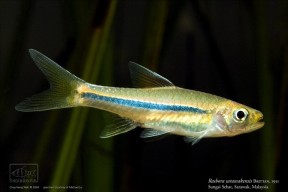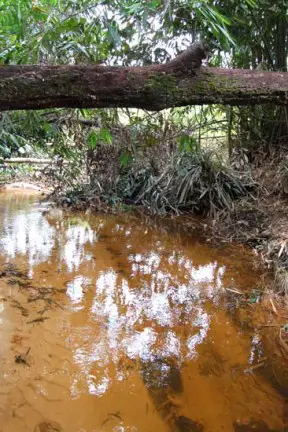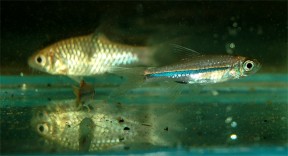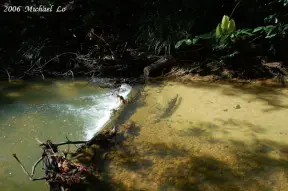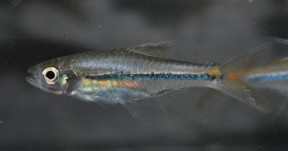Rasbora sarawakensis
Classification
Cyprinidae
Distribution
Endemic to the island of Borneo. Although the name may suggest otherwise it is not only found in Sarawak state (Malaysia) but also ranges into neighbouring West Kalimantan/Kalimantan Barat province (Indonesia). It has been recorded from numerous river systems including the Batang Kayan and Sungai Sarawak in Sarawak and the Mempawah and Melawi in Kalimantan Barat.
Habitat
Mostly inhabits slow-moving forest streams with thick marginal vegetation. These are often shaded by the dense rainforest canopy above. The substrate is most often composed of a thick layer of silt littered with fallen tree branches and leaf litter and the water is quite clear but coloured weakly brown due to tannins released from the decomposing organic matter. At one typical locality in Sarawak sympatric species included Rasbora borapetensis, Puntius kuchingensis, P. sealei, Hemirhamphodon pogonognathus, Betta taeniata and an unidentified Nemacheilus species.
Maximum Standard Length
Around 2″/5cm.
Aquarium SizeTop ↑
A tank measuring 24″ x 15″ x 12″/60cm x 37.5cm x 30cm/70.8 litres is big enough to house a small group of these.
Maintenance
Choice of decor is unlikely to be critical although other small rasboras tend to show better colouration when maintained in a well-planted set-up with a dark substrate. The addition of some floating plants and driftwood roots or branches to diffuse the light entering the tank also seems to be appreciated and adds a more natural feel. Filtration does not need to be particularly strong as it mostly hails from sluggish waters and may struggle if there is a fast current in the tank.
Water Conditions
Temperature: 72 – 78°F/22 – 26°C
pH: 6.0 – 7.5
Hardness: 2 – 12°H
Diet
Probably feeds mostly on invertebrates both aquatic and terrestrial in nature as with similar members of the genus. In the aquarium it should accept dried foods of a suitable size but should not be fed these exclusively. Daily meals of small live and frozen fare such as Daphnia, bloodworm and suchlike will result in the best colouration and encourage the fish to come into breeding condition.
Behaviour and CompatibilityTop ↑
This species should make an ideal addition to a peaceful community of Southeast Asian/Indian species such as other similarly-sized Rasbora, Puntius, botiid/cobitid loaches and gouramis of the genus Trichogaster. In a biotope set-up you could try it alongside other Bornean species; there are many suitable choices but some of the more commonly exported examples include Rasbora borapetensis, R. einthovenii, Trichogaster trichopterus and Pangio semicincta.
It’s a schooling species by nature and really should be kept in a group of at least 8-10 specimens. Maintaining it in decent numbers will not only make the fish less nervous but will result in a more effective, natural-looking display. Males will also display their best colours as they compete with one other for female attention.
Sexual Dimorphism
Mature females should be noticeably rounder-bellied and probably a little larger than males.
Reproduction
We’re not sure if it has been bred in the hobby although it should certainly be possible. Like most cyprinids this species is an egg-scattering, continuous spawner that exhibits no parental care. That is to say when the fish are in good condition they will spawn often and in a densely-planted, mature aquarium it is possible that small numbers of fry may start to appear without human intervention.
However if you want to increase the yield of fry a slightly more controlled approach is required and we suggest beginning with an approach that has proven successful for other small members of the genus. The adult group can still be conditioned together but one or more long, shallow, say 18″ x 10″ x 10″/45cm x 20cm x 20cm/29.5 litre containers should also be set up and half-filled with water. These should be very dimly lit and the base covered with some kind of mesh of a large enough grade so that the eggs can fall through it but small enough so that the adults cannot reach them. The widely available plastic ‘grass’-type matting can also be used and works very well for other species. The water itself should be of slightly acidic to neutral pH with a temperature towards the upper end of the range suggested above. An internal power filter can be added initially and this should be positioned so that the flow is directed down the full length of the tank.
When the adult fish are well-conditioned and the females appear full of eggs one or two pairs should then be introduced to each container. Spawning can be initiated by adding small amounts of cool water every few hours in such a way that the tank is gradually topped up and feeding small amounts of live and frozen foods. Several spawning events will probably occur before a female is spent of eggs.
The adults will likely eat any eggs they find and are best removed after a couple of days at which point the power filter should be switched for a mature sponge-type unit in order to avoid fry being sucked into the mechanism. Incubation in Rasbora eggs is temperature-dependant to an extent but usually takes between 18 and 48 hours with the young free-swimming 24 to 48 hours later. Initial food should be Paramecium or similar introducing Artemia nauplii and/or microworm once the fry are large enough to accept them.
NotesTop ↑
R. sarawakensis is poorly-documented in the aquarium literature and we’re not even sure if it has been exported for the hobby although it may be worth looking out for among shipments of wild fish from southern/western Borneo. We find this a little odd as it is an attractive, very peaceful little fish that would suit many home aquaria and is apparently quite common across its natural range.
Rainboth’s ‘Fishes of the Cambodian Mekong’ characterised members of Rasbora by possession of an unbranched, non-spiny first dorsal fin ray and seven soft dorsal rays, origin of the dorsal fin in the middle of the body, five branched anal fin rays, a small mouth not extending below the eye and a lack of barbels. It’s long been recognised as a polyphyletic lineage as noted by Kottelat (1999) amongst others, and in 2010 the results of a phylogenetic analysis by T. Y. Liao et al. suggested a number of changes in order to improve the taxonomy. The authors found species of rasborin genera to actually represent a monophyletic grouping existing in six clades and erected four new genera (all containing former members of Rasbora) in order to preserve monophyly of the existing groups i.e. Boraras, Horadandia, Rasbora, Rasboroides and Trigonostigma.
According to the authors the first two clades are monotypic; R. brittani should now be referred to as Kottelatia brittani and R. dorsiocellata as Brevibora dorsiocellata. The third clade comprises Boraras brigittae, Horadandia atukorali, Rasboroides vaterifloris, Trigonostigma heteromorpha and three species previously included in Rasbora but also moved into new genera; Trigonopoma gracile, T. pauciperforatum and Rasbosoma spilocerca. The results for B. brigittae and T. heteromorpha were found to be inconclusive in some respects and further work regarding their phylogenetic position was recommended.
The fourth clade includes Rasbora semilineata, R. borapetensis, R. rubrodorsalis and an undescribed fish similar to R. beauforti. Clade five consists of R. daniconius, R. hubbsi, R. paucisqualis, R. wilpita, R. kobonensis, R. ornata and R. cf. daniconius. Clade six, meanwhile, is subdivided into two groupings. The first contains R. einthovenii, R. elegans and R. cephalotaenia and the second R. lateristriata, R. argyrotaenia, R. volzii, R. paviana, R. rasbora (plus an undescribed, similar fish), R. caudimaculata and R. trilineata. As this final clade contains the type species (see below) its members retain the generic name Rasbora as do clade five species because they don’t differ sufficiently to warrant a the erection of a new genus/genera.
Unfortunately many species weren’t included in the analysis, meaning inevitable questions are raised regarding the correct placement of the 40 or so other Rasboras, in particular. As the genus had previously been split into various ‘species groups’ (groups of closely-related species) dating back to Brittan (1972, who referred to them as ‘species complexes’) Liao et al. proposed the following arrangement whilst noting it may be subject to change with further phylogenetic studies:
R. semilineata species group: R. semilineata, R. borapetensis, R. rubrodorsalis.
R. trifasciata species group: R. trifasciata, R. amplistriga, R. api, R. bankanensis, R. dies, R. ennealepis, R. hubbsi, R. johannae, R. kluetensis, R. meinkeni, R. nodulosa, R. paucisqualis, R. rutteni, R. sarawakensis, R. taytayensis, R. tobana, R. truncata, R. tuberculata.
R. daniconius species group: R. daniconius, R. armitagei, R. dandia, R. kobonensis, R. labiosa, R. microcephalus, R. ornata, R. wilpita.
R. einthovenii species group: R. einthovenii, R. cephalotaenia, R. elegans, R. jacobsoni, R. kalochroma, R. kottelati, R. nematotaenia, R. patrickyapi, R. tubbi.
R. argyrotaenia species group: R. argyrotaenia, R. aprotaenia, R. aurotaenia, R. baliensis, R. borneensis, R. bunguranensis, R. dusonensis, R. evereti, R. hobelmani, R. hossi, R. lateristriata, R. laticlavia, R. leptosoma, R. philippina, R. septentrionalis, R. spilotaenia, R. steineri, R. tawarensis, R. tornieri, R. volzii.
R. sumatrana species group: R. sumatrana, R. atridorsalis, R. calliura, R. caudimaculata, R. dorsinotata, R. notura, R. paviana, R. rasbora, R. subtilis, R. trilineata, R. vulgaris.
Not classified: R. beauforti, R. chrysotaenia, R. gerlachi (validity in question), R. lacrimula (said to compare most closely with R. dies and R. semilineata which are members of the R. trifasciata and R. semilineata groups, respectively) R. kalbarensis, R. reticulata, R. vulcanus (possibly not Rasboras) and R. zanzibarensis (identity in question).
NB – this list has been amended from that published in Liao et al. to reflect subsequent new species descriptions and taxonomical changes.
Shortly afterwards a paper investigating systematics of the subfamily Danioninae was published by Tang et al. (2010) Their results differed wildly from those of Liao et al. and the four new genera plus Boraras and Trigonostigma were synonymised with Rasbora based on an incomplete knowledge of relationships within the group, an approach they describe as ‘more conservative’. Though perhaps neither conclusion is satisfactory we decided to adopt the system of Liao et al. pending future studies, if only because we prefer to retain Boraras and Trigonostigma.
The identity of the type species, often given as R. rasbora in the past, is no longer in question; when Bleeker first referred to the name Rasbora in 1859 only four nominal members were included of which R. cephalotaenia (known as Leuciscus cephalotaenia at the time) should be considered the type. Howes (1980) suggested the separation of a number of species into the new genus Parluciosoma with type species P. (Rasbora) argyrotaenia but the monophyly of that grouping was not recovered by Liao et al..
References
- www.petfrd.com
- Kottelat, M. 1999 - Raffles Bull. Zool. 47(2): 591-600.
Nomenclature of the genera Barbodes, Cyclocheilichthys, Rasbora and Chonerhinos (Teleostei: Cyprinidae and Tetraodontidae), with comments on the definition of the first reviser. - Liao, T. Y., Kullander, S. O. and F. Fang. 2010 - Zoologica Scripta 39: 155-176
Phylogenetic analysis of the genus Rasbora (Teleostei: Cyprinidae). - Mayden, R. L., K. L. Tang, K. W. Conway, J. Freyhof, S. Chamberlain, M. Haskins, L. Schneider, M. Sudkamp, R. M. Wood, M. Agnew, A. Bufalino, Z. Sulaiman, M. Miya, K. Saitoh and S. He. 2007 - J. Exp. Zool. (Mol. Dev. Evol.) 308B: 1–13.
Phylogenetic relationships of Danio within the order Cypriniformes: a framework for comparative and evolutionary studies of a model species. - Tang, K. L., M. K. Agnew, W. J. Chen., M. V. Hirt, T. Sado, L. M. Schneider, J. Freyhof, Z. Sulaiman, E. Swartz, C. Vidthayanon, M. Miya, K. Saitoh, A. M. Simons, R. M. Wood and R. L. Mayden. 2010 - Molecular phylogenetics and evolution 57(1): 189-214
Systematics of the subfamily Danioninae (Teleostei: Cypriniformes: Cyprinidae).
